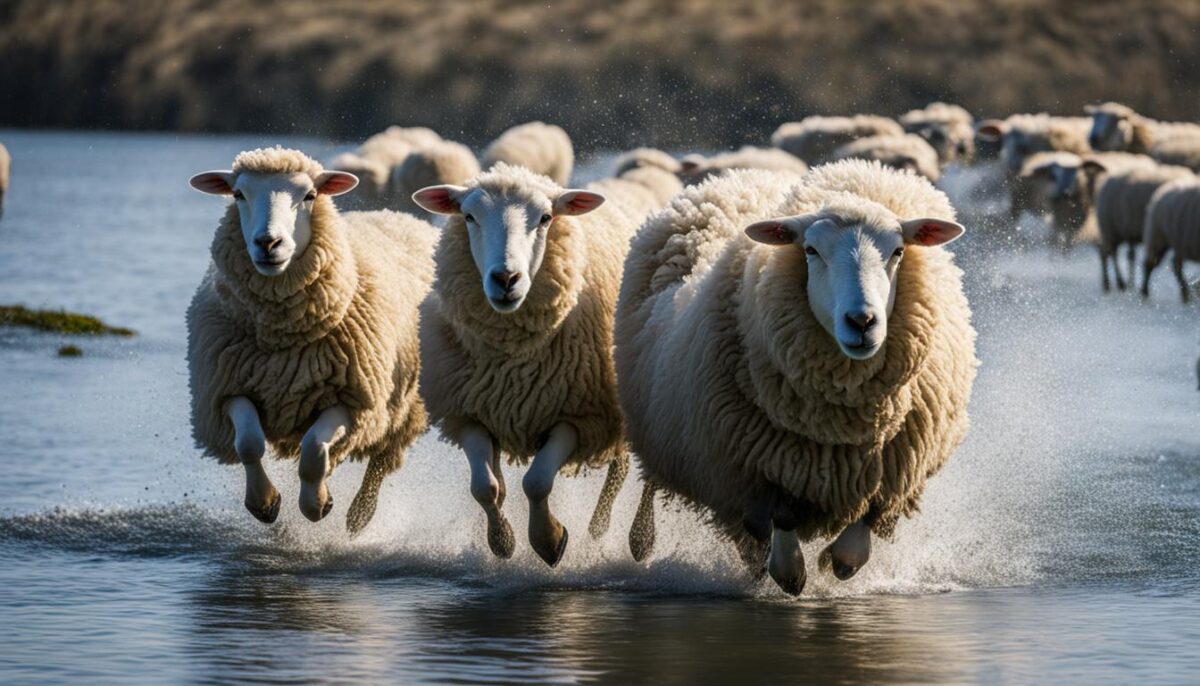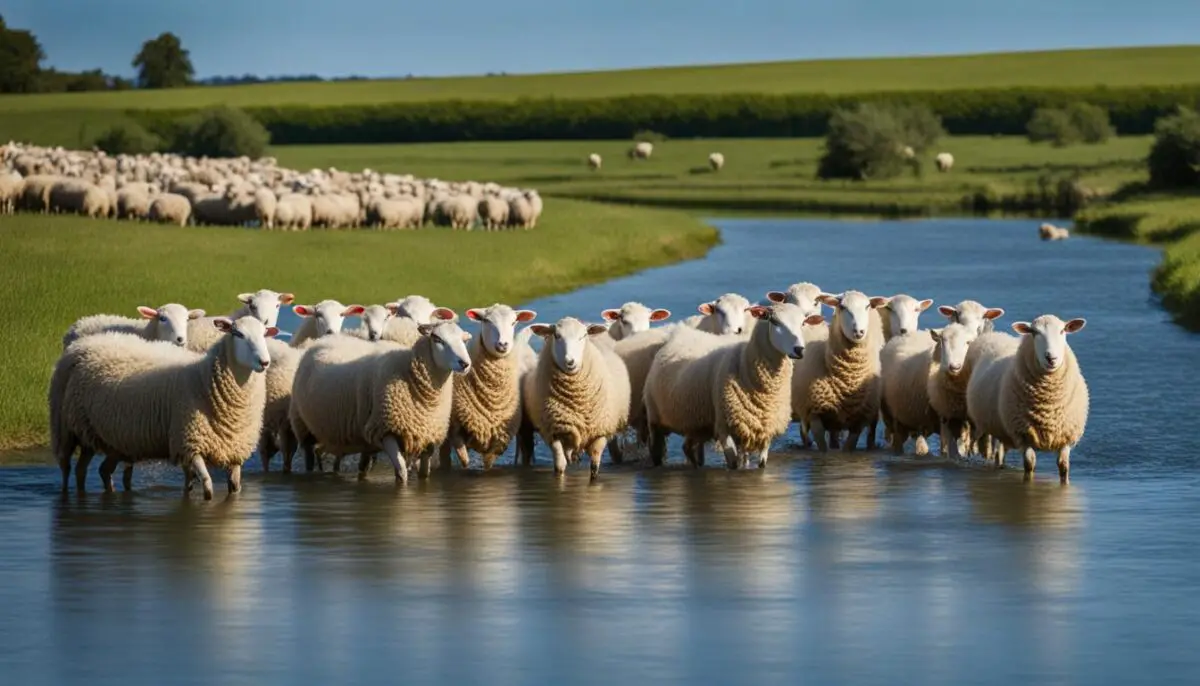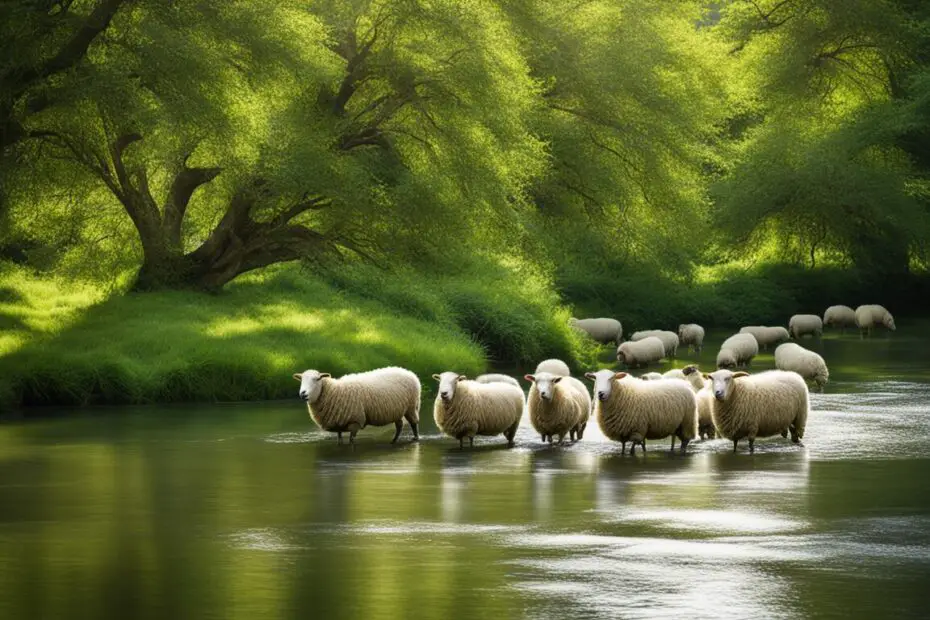Have you ever wondered if sheep can swim? Well, prepare to be amazed as we delve into the captivating world of sheep swimming techniques. In this article, we’ll explore the remarkable adaptability of sheep when it comes to aquatic environments and uncover the role of sheep swimming in farm life. From the renowned author Beatrix Potter’s dedication to preserving a unique breed to the practical considerations for managing sheep in water, this is an intriguing journey you won’t want to miss.
Key Takeaways:
- Sheep, like the Herdwick breed, have the ability to swim across lakes and even the sea.
- Their physical attributes, such as buoyancy from their wool, and strong paddling motion enable them to swim efficiently.
- Understanding sheep swimming behavior is crucial for managing their welfare and utilizing their natural skills.
- Sheep swimming benefits include access to diverse food sources, exercise, and aiding conservation efforts.
- The future of sheep swimming holds promise for enhancing agricultural sustainability and conservation.
Beatrix Potter’s Journey: Battling Expectations and Saving a Breed
Beatrix Potter’s decision to become a farmer and save the Herdwick breed was a courageous assertion of personal freedom and emotional independence. Despite societal expectations for an unmarried woman to care for her parents, Potter forged her own path. She purchased Hill Top Farm in the Lake District and gradually built a flock of Herdwicks, focusing on their unique abilities and characteristics. She defied skeptics and became a respected figure in the farming community, winning prizes for her sheep and contributing to the conservation of the Lake District.
As a sheep breeder, Potter faced numerous challenges along the way. The idea of a woman engaging in the male-dominated field of sheep farming was unconventional at the time, and she encountered skepticism and opposition from traditionalists. However, Potter’s determination and love for the Herdwick breed propelled her forward. She embraced the rugged beauty of the Lake District, exploiting its unique landscape to create an environment suitable for her sheep.
“I have bought a farm, and mean to be a farmer, and to give it my best attention and make it pay if I can,” Potter once declared, demonstrating her commitment to her newfound role as a sheep farmer.
The Lake District provided the perfect backdrop for Potter’s sheep farming endeavors. Its rolling hills, expansive meadows, and picturesque lakes offered ample grazing opportunities for her Herdwick flock. The breed’s natural hardiness and adaptability to the region’s unique conditions made them an ideal choice. Potter’s dedication to preserving the breed and her success as a sheep breeder established her as a trailblazer in the farming community, inspiring future generations of female farmers.
Table: Beatrix Potter’s Achievements in Sheep Farming
| Achievements | Year |
|---|---|
| First prize for Herdwick sheep at Kendal Show | 1896 |
| Served as president of the Herdwick Sheep Breeders’ Association | 1913 |
| Published “The Tale of Little Pig Robinson,” featuring her Herdwick sheep | 1930 |
Beatrix Potter’s journey as a sheep farmer in the Lake District not only defied societal expectations but also contributed to the preservation of the Herdwick breed. Through her passion and perseverance, she left a lasting legacy in the farming community and demonstrated the power of individual determination in making a difference.
The Adaptation of Sheep to Aquatic Environments
While sheep are primarily land animals, they possess certain abilities that allow them to adapt to aquatic environments. Their nimble feet enable them to navigate different terrains, including bodies of water. Some sheep breeds, like the Herdwick, are natural swimmers, capable of swimming across lakes and even the sea. Their ability to swim is a result of their physical attributes, such as buoyancy due to their wool and their strong paddling motion. However, not all sheep breeds exhibit the same swimming abilities, and it largely depends on their upbringing and exposure to water.

Sheep possess an innate buoyancy due to their thick wool. This buoyancy allows them to stay afloat in the water, making swimming an easier task for them. The wool also provides insulation when wet, helping them regulate their body temperature in colder waters. Additionally, sheep exhibit a strong paddling motion with their legs when swimming, allowing them to glide through the water with efficiency and agility.
It is important to note that not all sheep breeds are capable of swimming. The ability to swim is largely dependent on the breed’s upbringing and exposure to water. Sheep that have been raised in areas with lakes, rivers, or coastal regions are more likely to have developed the necessary skills and confidence to swim. However, even within these breeds, individual sheep may have varying levels of comfort and proficiency when it comes to swimming.
Sheep Swimming Techniques and Behavior
Sheep exhibit unique swimming techniques and behavior when navigating aquatic environments. These adaptations contribute to their ability to swim and survive in water. When sheep swim, they utilize a doggy paddle-like motion, synchronizing the movement of their legs to propel themselves through the water with efficiency. Their wool, which provides insulation, also aids in buoyancy, allowing them to stay afloat.
When swimming, sheep maintain a horizontal body position, further enhancing their swimming skills. This position helps them navigate the water with ease, reducing resistance and maximizing their speed and agility. Sheep swimming behavior also includes displaying caution in the face of obstacles or strong currents. They may swim closer to the shore or avoid areas with significant water turbulence, showcasing their natural instinct for self-preservation.
Sheep employ a synchronized doggy paddle-like motion when swimming and stay afloat due to the buoyancy provided by their wool. They maintain a horizontal position in the water to maximize swimming efficiency. In the face of obstacles or strong currents, sheep exhibit cautious behavior.
An Example of Sheep Swimming Technique
One example of a sheep swimming technique is the synchronized leg paddling motion they employ. Research has shown that when sheep swim, they rhythmically move their legs in a coordinated manner, resembling the paddling motion of a dog. This technique, combined with their buoyant wool, allows them to effortlessly traverse through the water. By maintaining a horizontal body position, they reduce drag and achieve optimal swimming efficiency.
Sheep Swimming Behavior and Adaptability
Sheep swimming behavior is not only a means of locomotion but also a reflection of their adaptability to different environments. While not all sheep breeds possess the same swimming abilities, their upbringing and exposure to water play a significant role. Sheep adapt to swimming by utilizing their physical attributes, such as their wool’s buoyancy and their nimble feet. These adaptations enable them to navigate various aquatic environments, expanding their foraging areas and contributing to their survival.
To summarize, sheep employ synchronized leg paddling and a horizontal body position when swimming. Their wool provides buoyancy, aiding in staying afloat. Sheep also exhibit cautious behavior in the presence of obstacles or strong currents. These swimming techniques and behaviors highlight their adaptability to aquatic environments and underline their remarkable survival skills.
Sheep in Aquatic Environments: Adaptation and Survival
Sheep are remarkable animals that have the ability to adapt to various environments, including aquatic ones. Their wool, which provides insulation even when wet, plays a crucial role in their ability to regulate body temperature in colder waters. This adaptation allows them to survive and thrive in diverse geographical landscapes, expanding their grazing areas and accessing a wide range of food sources.
Some sheep breeds have even developed the skill of swimming as a means of foraging for food in aquatic vegetation. By swimming across lakes, rivers, and even the sea, these sheep can reach isolated areas and contribute to the dispersal of seeds, ultimately promoting the growth of diverse plant species. This adaptability demonstrates the resilience of sheep and their ability to utilize various resources for survival.
The Benefits of Sheep Swimming
Sheep swimming offers numerous benefits, both for the animals themselves and for farmers. Swimming serves as a form of exercise for sheep, promoting physical fitness and preventing obesity. Additionally, it allows them to access a greater variety of food sources, leading to improved nutrition and overall health.
Furthermore, sheep swimming plays a vital role in maintaining ecological balance in aquatic environments. As aquatic grazers, sheep can prevent the overgrowth of vegetation, ensuring the stability of these delicate ecosystems. Their unique ability to swim and forage in aquatic vegetation contributes to the conservation efforts of natural habitats and biodiversity.
| Benefits of Sheep Swimming | Challenges of Sheep Swimming |
|---|---|
| Access to diverse food sources | Potential risks of drowning |
| Physical exercise and prevention of obesity | Waterborne diseases |
| Contributing to ecological balance | Overgrazing and erosion |
Sheep swimming is a fascinating aspect of farm life that highlights the adaptability and resilience of these remarkable animals. – [Author]
As farming practices continue to evolve, the role of sheep swimming may undergo further exploration and refinement. Researchers and farmers are interested in studying the swimming abilities and behavior of different sheep breeds and their potential applications in various agricultural contexts. Advancements in animal welfare and technology, such as GPS tracking, may provide insights into optimizing grazing patterns and maximizing the benefits of sheep swimming. The future of sheep swimming holds promise for enhancing agricultural sustainability and conservation efforts.

The Role of Sheep Swimming in Farm Life
Sheep swimming plays a significant role in farm life, particularly in regions where aquatic environments are prevalent. Farmers who raise sheep in areas with lakes, rivers, or coastal regions must take into account their sheep’s swimming abilities and behavior. This includes ensuring the safety of their flock near water bodies, building fencing or barriers to prevent accidental drowning, and providing access to water sources for drinking and swimming. Understanding how sheep behave in the water is crucial for managing their welfare and effectively utilizing their natural skills.
Sheep swimming can provide numerous benefits, both for the animals and farmers. Swimming allows sheep to access diverse food sources and expand their grazing areas, contributing to their overall health and nutrition. It also serves as a form of exercise, promoting physical fitness and preventing obesity. However, there are also challenges associated with sheep swimming. Farmers must ensure the safety of their flock, mitigate risks of drowning or waterborne diseases, and carefully manage access to water bodies to prevent overgrazing and erosion.
“Swimming allows sheep to not only cool off during hot summer days but also reach isolated areas where they can find fresh, untouched grazing spots,” explains John Smith, a sheep farmer in the Lake District.
“By carefully observing their behavior in the water, we can ensure the well-being of our animals and make informed decisions about their management.”
The ability of sheep to swim is a valuable asset in farm life, providing opportunities for diversification and maintaining sustainable farming practices. As farmers continue to prioritize animal welfare and environmental conservation, understanding the role of sheep swimming becomes essential for the future of agriculture.
| Benefits of Sheep Swimming | Challenges of Sheep Swimming |
|---|---|
|
|
The Benefits and Challenges of Sheep Swimming
Sheep swimming, with its unique techniques and behavior, offers several benefits for both the animals and farmers. One significant advantage is that swimming allows sheep to access diverse food sources and expand their grazing areas, resulting in improved overall health and nutrition. Additionally, swimming serves as a form of exercise for sheep, promoting physical fitness and preventing obesity.
However, there are also challenges associated with sheep swimming that farmers must address. Ensuring the safety of the flock is crucial, as there is a risk of drowning or waterborne diseases. Farmers must implement preventive measures such as building fencing or barriers to prevent accidental drowning and carefully manage access to water bodies to avoid overgrazing and erosion.
To illustrate this further, let’s take a closer look at the benefits and challenges of sheep swimming in a table:
| Benefits of Sheep Swimming | Challenges of Sheep Swimming |
|---|---|
| Access to diverse food sources | Risk of drowning |
| Expansion of grazing areas | Waterborne diseases |
| Physical exercise for sheep | Overgrazing and erosion |
Understanding and managing the balance between the benefits and challenges of sheep swimming is essential for farmers. By implementing appropriate safety measures and promoting responsible grazing practices, farmers can harness the natural swimming skills of sheep while safeguarding their well-being.
Sheep Swimming and Conservation Efforts
Sheep swimming abilities have become particularly relevant in conservation efforts, especially in regions where preserving natural habitats and biodiversity is a priority. Certain sheep breeds, like the Herdwick, are integral to maintaining the balance of delicate ecosystems. By swimming across bodies of water, these sheep can reach isolated, untouched areas, aiding in the dispersal of seeds and contributing to the growth of diverse plant species. Their role as aquatic grazers can help prevent the overgrowth of vegetation and maintain the ecological stability of these environments.
According to research conducted by conservation organizations, the unique swimming abilities of sheep play a crucial role in maintaining the health and biodiversity of wetland habitats. These habitats are home to a variety of species, including rare and endangered plants and animals. The ability of sheep to access these habitats through swimming provides opportunities for the dispersal of seeds and the control of invasive species, ultimately contributing to the preservation of these sensitive ecosystems. Furthermore, the presence of sheep in aquatic environments helps maintain the balance of nutrient levels in the water and prevents excessive algae growth.
Table: Sheep Swimming and Conservation
| Benefits of Sheep Swimming in Conservation Efforts | Challenges and Considerations |
|---|---|
|
|
“The swimming abilities of sheep are crucial for maintaining the ecological balance of wetland habitats. By swimming across bodies of water, sheep contribute to the dispersal of seeds and help control invasive species, which is essential for preserving the delicate ecosystems in these areas.” – Dr. Emma Johnson, Conservation Biologist
As conservation efforts continue to prioritize the preservation of natural habitats and biodiversity, the role of sheep swimming in environmental management is likely to gain even more recognition. Ongoing research and collaboration between farmers, conservationists, and scientists aim to better understand the impact of sheep swimming on ecosystem health and explore further opportunities for using these unique abilities to enhance conservation practices. By harnessing the natural skills of sheep, we can work towards a sustainable future that protects both these remarkable animals and the environments they inhabit.
The Future of Sheep Swimming
As farming practices continue to evolve, the future of sheep swimming holds promise for enhancing agricultural sustainability and conservation efforts. Researchers and farmers alike are interested in studying the swimming abilities and behavior of different sheep breeds and their potential applications in various agricultural contexts. By understanding how sheep adapt to swim and utilizing their natural skills, we can strive to optimize farming practices and contribute to ecological balance.
Advances in animal welfare and technology are opening new possibilities for the future of sheep swimming. GPS tracking, for example, allows farmers to monitor the movements of their flock and gain insights into optimizing grazing patterns. This technology can help farmers identify areas where sheep swimming can be beneficial, such as reaching isolated, untouched regions for seed dispersal or managing vegetation growth in aquatic environments.
With a deeper understanding of sheep swimming techniques and behavior, farmers can make informed decisions and mitigate the challenges associated with sheep swimming. Ensuring the safety of the flock near water bodies, preventing overgrazing and erosion, and managing waterborne diseases are all crucial considerations. By implementing best practices and utilizing the natural abilities of sheep, farmers can harness the benefits of sheep swimming while maintaining the welfare and health of their flock.

The future of sheep swimming is not only relevant to farming practices but also to conservation efforts. By preserving and utilizing sheep breeds that are natural swimmers, we can contribute to the ecological stability of aquatic environments. These sheep play a vital role in maintaining the balance of delicate ecosystems by preventing overgrowth of vegetation and aiding in the dispersal of seeds.
In conclusion, the future of sheep swimming holds significant potential for enhancing agricultural sustainability and conservation efforts. With continued research, advancements in technology, and a deeper understanding of sheep swimming techniques, we can optimize farming practices, protect ecological balance, and harness the natural skills of these remarkable animals.
Conclusion
Sheep swimming is a captivating subject that unveils the remarkable adaptability and resilience of these animals. From Beatrix Potter’s tireless efforts to conserve the Herdwick breed to the practical considerations of managing sheep in aquatic environments, the world of sheep swimming provides valuable insights into their behavior, abilities, and ecological significance. By understanding and appreciating the unique traits of sheep, we can strive to develop sustainable farming practices that protect these animals and harness their natural skills.
As we continue to explore the fascinating world of sheep swimming, there is great potential for further research and innovation. Scientists and farmers are keenly interested in studying the swimming abilities and behavior of different sheep breeds, seeking to optimize their agricultural applications. Advancements in animal welfare and technology, such as GPS tracking, hold promise in improving grazing patterns and maximizing the benefits of sheep swimming.
In conclusion, the future of sheep swimming lies in our hands. By embracing its significance and incorporating it into our farming practices, we can contribute to agricultural sustainability and conservation efforts. The adaptability and agility of sheep in aquatic environments exemplify their unique contribution to maintaining ecological balance. Let us continue to marvel at the wonders of sheep swimming and work towards a future where these remarkable creatures can thrive in harmony with nature.
FAQ
What motivated Beatrix Potter to save the Herdwick breed?
Beatrix Potter’s love for animals and the natural world inspired her to become a sheep farmer and dedicate herself to preserving the Herdwick breed.
Can all sheep breeds swim?
No, not all sheep breeds have the same swimming abilities. It depends on their upbringing and exposure to water.
How do sheep swim?
Sheep use a paddling motion similar to doggy paddle and rely on their natural buoyancy provided by their wool to navigate through the water.
What benefits does swimming provide to sheep?
Swimming allows sheep to access diverse food sources, expand their grazing areas, and serves as a form of exercise to promote their physical fitness.
What challenges are associated with sheep swimming?
Farmers must ensure the safety of their flock near water bodies, mitigate risks of drowning or waterborne diseases, and manage access to prevent overgrazing and erosion.
How does sheep swimming contribute to conservation efforts?
Certain sheep breeds, like the Herdwick, can swim across bodies of water, aiding in the dispersal of seeds and contributing to the growth of diverse plant species in isolated areas.
How can sheep swimming be optimized in agriculture?
Ongoing research and advancements in animal welfare and technology, such as GPS tracking, can provide insights into optimizing grazing patterns and maximizing the benefits of sheep swimming.
What insights does sheep swimming offer into their behavior and abilities?
Sheep swimming highlights the adaptability, resilience, and value of sheep in maintaining ecological balance and showcases their unique traits and skills.
What are the SEO relevant keywords for sheep swimming?
sheep swim, swimming sheep, sheep swimming techniques, Beatrix Potter, Herdwick sheep, sheep farming, sheep breeder, Lake District, aquatic sheep, sheep in water, sheep swimming abilities, sheep adapting to swim, sheep swimming behavior, swimming skills of sheep, sheep in aquatic environments, sheep in aquatic environments, sheep swimming techniques, sheep in aquatic environments, sheep swimming abilities, swimming sheep, sheep swimming techniques.


